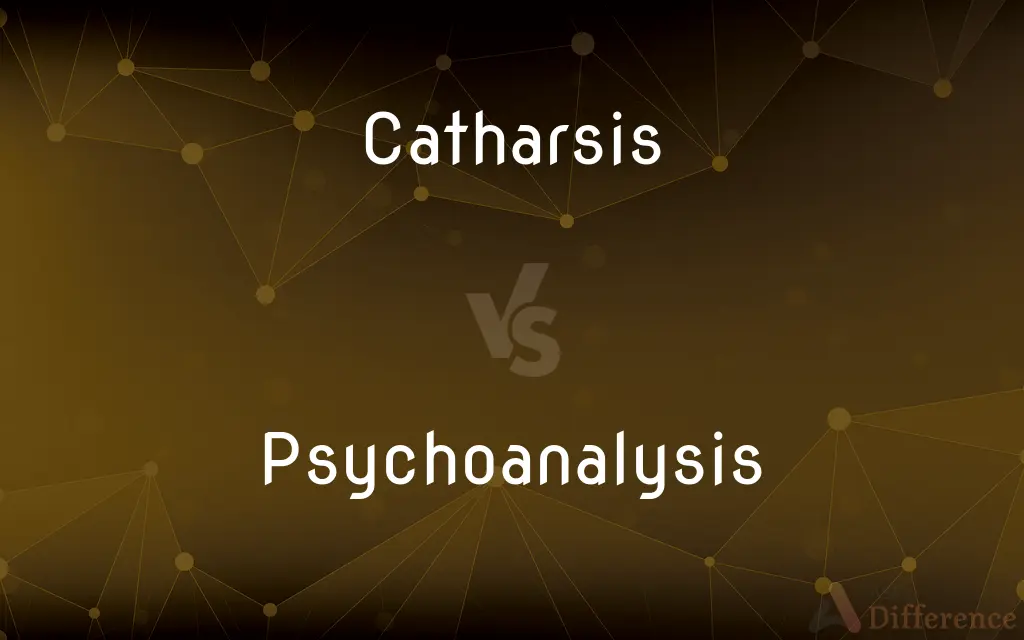Catharsis vs. Psychoanalysis — What's the Difference?
By Tayyaba Rehman & Fiza Rafique — Updated on April 8, 2024
Catharsis involves emotional release, often leading to healing and insight, whereas psychoanalysis is a therapeutic technique focusing on understanding unconscious motivations.

Difference Between Catharsis and Psychoanalysis
Table of Contents
ADVERTISEMENT
Key Differences
Catharsis is primarily associated with the emotional relief experienced after expressing emotions that were previously repressed or unacknowledged, often leading to a sense of renewal or liberation. Whereas psychoanalysis, developed by Sigmund Freud, is a more structured approach that seeks to uncover and interpret the unconscious thoughts and desires influencing behavior.
Catharsis can occur spontaneously or be facilitated through various activities like art, writing, or therapy, where individuals are encouraged to express their deepest feelings. On the other hand, psychoanalysis requires a psychoanalyst to guide the individual through techniques like free association, dream analysis, and transference to explore the unconscious mind.
While catharsis emphasizes the emotional aspect of healing, psychoanalysis places a significant focus on cognitive understanding and interpretation of one’s internal world. Psychoanalysis aims not just for emotional release but for insight and resolution of internal conflicts.
Cathartic experiences are not limited to the clinical setting and can be a part of everyday life experiences, such as watching a moving film or overcoming a personal challenge. Psychoanalysis, however, is a deliberate therapeutic process that involves regular sessions over years to delve deeply into one’s psyche.
In terms of outcomes, catharsis may lead to immediate but temporary relief from emotional distress, providing a moment of clarity or peace. Psychoanalysis, however, aims for long-term transformation of personality and behavioral patterns through a deeper understanding of oneself.
ADVERTISEMENT
Comparison Chart
Efinition
Emotional release leading to renewal or liberation.
Therapeutic technique uncovering unconscious motivations.
Origin
Ancient Greek theater; concept of emotional purification.
Developed by Sigmund Freud in the late 19th century.
Primary Focus
Emotional expression and relief.
Understanding and interpreting unconscious thoughts and desires.
Methods
Art, writing, therapy, or any activity that facilitates emotional release.
Free association, dream analysis, transference.
Setting
Can occur in or out of clinical settings.
Requires a clinical setting with a trained psychoanalyst.
Outcome
Immediate emotional relief, potentially temporary.
Long-term insight into and resolution of psychological issues.
Compare with Definitions
Catharsis
Emotional release through art.
Painting helps him achieve catharsis after a stressful week.
Psychoanalysis
Process of uncovering underlying motivations.
Through psychoanalysis, she discovered the roots of her anxieties.
Catharsis
Relief from expressing feelings.
Sharing her story with the group provided a sense of catharsis.
Psychoanalysis
Technique involving dream analysis.
His psychoanalyst used dream analysis to interpret subconscious desires.
Catharsis
Healing process involving emotional expression.
Writing poetry is her catharsis for dealing with grief.
Psychoanalysis
Therapy exploring the unconscious.
She began psychoanalysis to understand her dreams.
Catharsis
Purification of emotions.
Watching tragic plays offers catharsis to the audience.
Psychoanalysis
Method using free association.
Psychoanalysis helped him uncover hidden memories.
Catharsis
Release from repressed emotions.
The therapy session allowed him a catharsis he hadn't felt in years.
Psychoanalysis
Long-term therapeutic approach.
Psychoanalysis requires a commitment to weekly sessions for several years.
Catharsis
Catharsis (from Greek κάθαρσις, katharsis, meaning "purification" or "cleansing" or "clarification") is the purification and purgation of emotions—particularly pity and fear—through art or any extreme change in emotion that results in renewal and restoration. It is a metaphor originally used by Aristotle in the Poetics, comparing the effects of tragedy on the mind of a spectator to the effect of catharsis on the body.
Psychoanalysis
Psychoanalysis (from Greek: ψυχή, psykhḗ, 'soul' + ἀνάλυσις, análysis, 'investigate') is a set of theories and therapeutic techniques that deal in part with the unconscious mind, and which together form a method of treatment for mental disorders. The discipline was established in the early 1890s by Austrian neurologist Sigmund Freud, who retained the term psychoanalysis for his own school of thought.
Catharsis
(Medicine) Purgation, especially for the digestive system.
Psychoanalysis
The method of psychological therapy originated by Sigmund Freud and dominant throughout most of the 20th century, in which free association, dream interpretation, and analysis of resistance and transference are used to explore repressed or unconscious impulses, anxieties, and internal conflicts, in order to free psychic energy for mature love and work.
Catharsis
A purifying or figurative cleansing of the emotions, especially pity and fear, described by Aristotle as an effect of tragic drama on its audience.
Psychoanalysis
Psychotherapy incorporating this method and theory.
Catharsis
A release of emotional tension, as after an overwhelming experience, that restores or refreshes the spirit.
Psychoanalysis
A family of theories and methods within the field of psychotherapy that work to find connections among patients' unconscious mental processes.
Catharsis
A technique used to relieve tension and anxiety by bringing repressed feelings and fears to consciousness.
Psychoanalysis
A method or process of psychotherapeutic analysis and treatment pf psychoneuroses, based on the work of Dr. Sigmund Freud (1856- 1939) of Vienna. The method rests upon the theory that neurosis is characteristically due to repression of desires consciously rejected but subconsciously persistent; it consists in a close analysis of the patient's mental history, effort being made to bring unconsciuos and preconscious material to consciousness; the methods include analysis of transferance and resistance. In some variants, stress is laid upon the dream life, and of treatment by means of suggestion.
Catharsis
The therapeutic result of this process; abreaction.
Psychoanalysis
The theory of human psychology which is the foundation for the psychoanalytic therapy, which explores the relation between conscious and unconscious mental processes in motivating human behavior and causing neuroses.
Catharsis
(drama) A release of emotional tension after an overwhelming vicarious experience, resulting in the purging or purification of the emotions, as through watching a dramatic production (especially a tragedy).
Psychoanalysis
An integrated set of theories of human personality development, motivation, and behavior based on a body of observations.
Catharsis
Any release of emotional tension to the same effect, more widely.
Psychoanalysis
One of several schools of psychotherapy, such as jungian psychoanalysis or freudian psychoanalysis.
Catharsis
A purification or cleansing, especially emotional.
Psychoanalysis
A set of techniques for exploring underlying motives and a method of treating various mental disorders; based on the theories of Sigmund Freud;
His physician recommended psychoanalysis
Catharsis
(psychology) A therapeutic technique to relieve tension by re-establishing the association of an emotion with the memory or idea of the event that first caused it, and then eliminating it by complete expression (called the abreaction).
Catharsis
(medicine) Purging of the digestive system.
Catharsis
A natural or artificial purgation of any passage, as of the mouth, bowels, etc.
Catharsis
The process of relieving an abnormal excitement by reëstablishing the association of the emotion with the memory or idea of the event that first caused it, and of eliminating it by complete expression (called the abreaction).
Catharsis
(psychoanalysis) purging of emotional tensions
Catharsis
Purging the body by the use of a cathartic to stimulate evacuation of the bowels
Common Curiosities
What is catharsis?
Catharsis refers to the emotional release and relief one experiences after expressing deep or repressed emotions.
Can anyone experience catharsis?
Yes, catharsis is a universal phenomenon that can be experienced by anyone under the right circumstances.
How does psychoanalysis differ from other therapies?
Psychoanalysis focuses on the exploration of the unconscious mind through techniques like free association and dream analysis, unlike therapies that focus on present behaviors and thoughts.
Is catharsis always beneficial?
While catharsis can provide immediate relief, it may not always resolve underlying issues without further reflection or therapy.
How long does psychoanalysis take?
Psychoanalysis can take several years, depending on the individual's needs and progress.
Is catharsis a goal in psychoanalysis?
While not the primary goal, catharsis can be a beneficial aspect of the psychoanalytic process, leading to emotional relief.
What is psychoanalysis?
Psychoanalysis is a therapeutic approach aimed at uncovering and understanding the unconscious thoughts and desires that influence behavior.
What are the main techniques used in psychoanalysis?
The main techniques include free association, dream analysis, and exploring the transference relationship between the analyst and the patient.
Can catharsis occur in psychoanalysis?
Yes, cathartic experiences can occur in psychoanalysis as individuals express and work through repressed emotions and thoughts.
How does catharsis work?
Catharsis works by allowing individuals to confront and express their emotions, leading to a sense of emotional purification and renewal.
Does psychoanalysis involve talking about dreams?
Yes, dream analysis is a key component of psychoanalysis, helping to reveal the unconscious content.
What is the difference between catharsis and emotional release?
Catharsis is a type of emotional release specifically characterized by the aspect of purification and renewal following the expression of repressed emotions.
Is psychoanalysis still practiced today?
Yes, psychoanalysis is still practiced and remains a foundational method in the field of psychotherapy.
What triggers catharsis?
Catharsis can be triggered by various experiences that allow for the expression of deep emotions, such as art, therapy, or significant life events.
Can psychoanalysis help with anxiety?
Yes, by uncovering and addressing the unconscious roots of anxiety, psychoanalysis can help individuals manage and reduce their anxiety levels.
Share Your Discovery

Previous Comparison
Bricklayer vs. Mason
Next Comparison
Tool vs. EquipmentAuthor Spotlight
Written by
Tayyaba RehmanTayyaba Rehman is a distinguished writer, currently serving as a primary contributor to askdifference.com. As a researcher in semantics and etymology, Tayyaba's passion for the complexity of languages and their distinctions has found a perfect home on the platform. Tayyaba delves into the intricacies of language, distinguishing between commonly confused words and phrases, thereby providing clarity for readers worldwide.
Co-written by
Fiza RafiqueFiza Rafique is a skilled content writer at AskDifference.com, where she meticulously refines and enhances written pieces. Drawing from her vast editorial expertise, Fiza ensures clarity, accuracy, and precision in every article. Passionate about language, she continually seeks to elevate the quality of content for readers worldwide.














































